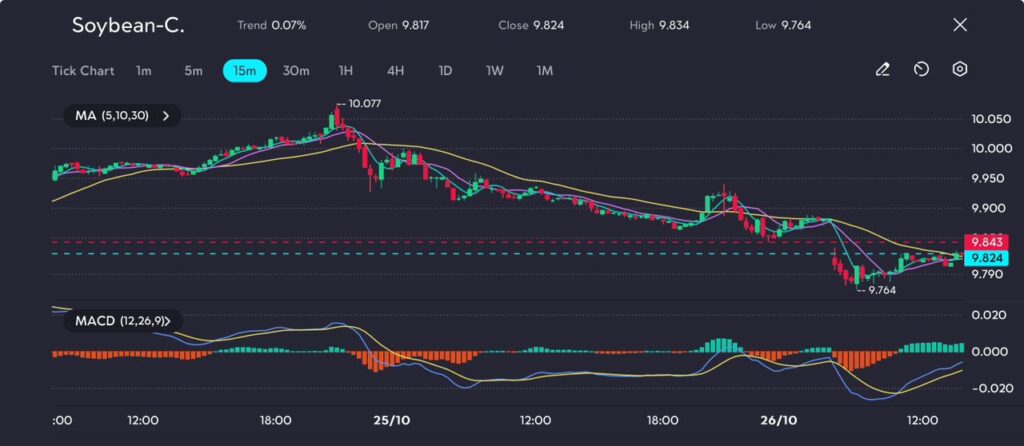Key Points:
- Soybean and corn prices are weighed down by record global supply, with ample US and South American harvests adding pressure.
- Wheat futures are hit by improved US weather conditions and forecasts of bumper southern hemisphere crops.
Soybean, corn, and wheat futures on the Chicago Board of Trade declined on Monday, with the mounting supply from US harvests continuing to pressure the market.
The most active soybean contract slipped by 0.7%, trading at $9.90-3/4 a bushel, while corn edged down 0.4% to $4.13-1/2 a bushel.

Picture: Soybean futures hover near support at 9.765, with slight MACD optimism hinting at potential buying interest, as seen on the VT Markets app.
The Soybean Futures chart shows a generally downward trend, with prices struggling to gain traction above the moving averages.
Recent activity suggests that the 9.765 level acts as a short-term floor, as prices have bounced off this point, leading to a period of consolidation.
However, the downward-sloping moving averages indicate the sellers are still in control.
Wheat futures followed the downtrend, losing 0.8% to $5.64-1/4 a bushel and marking a seven-week low.
The global grain market is currently characterised by robust supply levels and heightened uncertainties surrounding the upcoming US election.
Additionally, favourable weather in South America continues to support planting activities, which could further increase future supply.
For wheat, recent rains in the drought-affected US Plains and more wet weather forecasts have eased concerns over planting delays.
This, coupled with expectations of record exports from the southern hemisphere, has added downward pressure on prices.
The Rosario Grains Exchange projects Argentina’s wheat exports to reach 13.3 million metric tons for the 2024-25 season, the second-highest level in history.
Australia is also on track for an above-average wheat yield, despite recent adverse weather impacts.
Soybean and corn prices have felt particular pressure as the US harvest progresses rapidly, contributing to global supply.
Although demand provided some support last week, the market continues to adjust to these supply pressures.
The Commodity Futures Trading Commission’s latest report shows that non-commercial traders increased their net short positions in CBOT wheat and soybeans, a trend that reflects continued bearish sentiment in the market.
Energy Market Impact
A weakened energy market has also influenced grain prices, with oil prices dropping by over $3 per barrel. This decline followed Israel’s retaliatory action over the weekend, which notably avoided impacting Tehran’s oil or nuclear infrastructure.
The resulting stability in oil markets has further eased immediate geopolitical concerns, particularly in the Middle East.
See also: Oil Climbs with Middle East Ceasefire Talks
With grain and oilseed markets often influenced by energy price trends, this easing of tensions has dampened demand for biofuel-linked crops like soybeans and corn.
Election Uncertainty and Market Volatility
With less than two weeks to go until the US presidential election, the tight race between Donald Trump and Kamala Harris in key swing states has left investors on edge.
A contested result remains a possibility, raising the prospect of heightened market volatility. Historically, election periods have amplified uncertainty in commodities markets, and traders are likely to remain cautious as Election Day approaches.
The market will likely keep a close watch on developments, with any indication of election delays or contestations potentially exacerbating volatility in grain prices.
Start trading now — click here to create your live VT Markets account.









